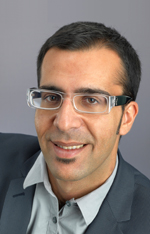OLED lighting will "competition" with LED lighting
The development of O led lighting is growing stronger. Because O- LED lighting has flat illumination and does not harm the eye, it attracts panel, material and equipment manufacturers to develop and develop new materials, equipment and process solutions, overcoming the challenges of material degradation and large-scale development. Divide the huge business opportunities in the lighting market.

Yo LED eveloppement market and technology analyst Pars Mukish
Organic light-emitting diodes (OLEDs) had a market size of only $500 million in 2009, but in the following years, they have continued to attract investors to invest in capital development, which is really intriguing. In fact, OLED has set off a development boom, partly because it can be used on mobile screens, such as the Samsung Galaxy series; the introduction of mobile screens has boosted OLED revenues to $3 billion in 2011 and reached in 2012. 6 billion US dollars.
In addition to the mobile phone screen, lighting is another very potential application of OLED. Although OLED lighting currently accounts for only a small part of the overall output value, the huge potential lighting market is expected to bring new revenue opportunities to OLED operators.
LED performance / cost to take advantage of OLED lighting still has time to develop
The way to improve traditional lighting with LED solid-state lighting has received a lot of attention from the industry, which has also raised doubts about how OLED will enter the lighting market in the future. Most people think that OLED will directly compete with LED technology, which means that OLED must overcome the current comparison with LED. Big performance and cost gaps.

Yola Developpement market and technology analyst Milan Rosina
At this stage, LED lighting luminous efficiency is 110 per watt lumen (lm / W), while commercial O led products up to 60lm / W; as for cost, LED technology cost is almost 5 US dollars / thousand lumens (klm), OLED is about At $350/klm, there is still a clear gap between the two technologies in the development of lighting applications. As a result, OLED technology is bound to take advantage of its unique light and glare, the size of the lamp can be large and flat, in order to successfully seize the lighting market.
Than standard LED and other light sources are required to cover light shade, vision loss may cause problems, O led to shield the light emitting source is not required to provide illumination is still another illumination future development; In addition, the OLED There are many different combinations of materials and structures that can be used to give a significant jump in luminous performance.
At present, OLED manufacturers have increased the efficiency by increasing the driving current, but at the cost of shorter component life. At the same time, the OLED structure can be stacked in series to improve the luminous efficiency, such as stacking two different structures during the deposition process. Together, driving with the same current will produce almost twice as much light. In this way, related companies can also use a lower current to drive the stacked O led panel , which can produce the same luminosity and increase the reliability, and overcome the problem of affecting the lifetime of the OLED due to the increase of current.
Although OLED lighting has potential for development, if it is seen as a direct competitor of LED in the lighting market, the difference in performance and cost may make OLED out in the foreseeable future. However, in the case of OLED lighting technology and luminaire design progress, two solid-state lighting technologies still need to exist at the same time, which has nothing to do with whether OLEDs compete with LEDs, or are not better technologies, because both lock The application is not exactly the same.
Considering the technical differences other than cost and luminous efficiency, if OLEDs reach the same level as LEDs, it will be a great achievement. In general, commercial LED products have a 20 to 25 year guaranteed life, and OLEDs are only 5 to 10 years. The main reason is that some materials in OLEDs are faster than other materials, and the color will change. This is in some industries or automobiles. The application is unacceptable.
Material cost / barrier layer designed to break through the focus of OLED
The o- lead material is eroded because the organic material layer is sensitive to oxygen and moisture. It must be carefully coated and protected by a permeation barrier. This will pose a serious challenge to the elastic design of the OLED panel. It is difficult for manufacturers to do it now. It is cost-effective and combines transparency, flexibility, and high temperature penetration into the barrier during manufacturing.
At this stage, 100% of commercial lighting OLEDs use glass as the substrate of the film layer, and put a piece of glass plate as a physical protective layer and a moisture/oxygen barrier layer (Fig. 1). However, even with these components, OLED organic materials It will still be eroded in a high temperature environment. In this case, an accelerated pressure test at a temperature above 85 °C will cause problems.
On the other hand, it is difficult for manufacturers with traditional lighting backgrounds to use OLED expertise to make lighting equipment. Therefore, OLED operators must also propose countermeasures to overcome the commercial and technical challenges of lighting. Especially now, OLED panels and traditional lighting equipment manufacturers are in charge. In a short period of time, OLEDs will have difficulty in penetrating the lighting market. The possible solution in the future is that OLED panel manufacturers produce their own lighting equipment, which is driven by technology rather than taking Traditional marketing strategy.
But another challenge is how to reduce OLED manufacturing expenditures. Three major issues can be found in the cost breakdown of commercial OLED panels. First, OLED manufacturing yields are very low, manufacturers do not have sufficient control, technology or experience in high-yield processes. Second, the cost of constructing O- LED production lines is high. For example, OSRAM has invested 20 million. Sterling is in the OLED pilot line in Regensburg, Germany. The third is the high cost of materials and equipment, and the high cost of OLED production lines is mainly because this is an emerging technology, so there is no standard equipment.
Since each OLED production line takes several months to build, equipment manufacturers also have to share the cost. Although OLED manufacturers claim to switch to ultra-thin layers to offset the high cost of complex molecular materials, most analysts believe that only half of them are due to material costs associated with manufacturing and materials in the luminaire panels, most of which are used for production. The material is deposited on the reactor wall or not deposited at all, resulting in wasted material.
In any case, OLED lighting has certain application advantages, and there are still many opportunities for improvement in manufacturing technology. Therefore, YoleDeveloppement predicts that OLED costs will be reduced to the current one-third level in the next two years, mainly due to the introduction of new generations. Production equipment, the use of larger mother glass substrates in the deposition reactor, to improve mass production benefits. At present, the manufacturer most commonly uses the second-generation mother glass plate of 47 cm × 37 cm, which can produce several standard OLED light-emitting panels of 10 cm × 10 cm.
Supply chain fully supports large-size OLED commercial
Future matt glass and OLED panel products will continue to evolve toward large size. The main consideration is that the 10 cm x 10 cm OLED panel is not enough to illuminate a room. It may take ten or more pieces, which will result in additional costs for each panel. If the cutting and the required connecting components are only a large panel, the manufacturing costs will naturally be reduced.
However, for large-size OLED panels, how to achieve the same luminosity on the entire panel surface will be a challenge. Many companies have begun to solve this problem, for example, OSRAM introduces a metal mesh into the electrode to improve the illuminance balance. According to the latest research report by YoleDeveloppement, before the major breakthrough in the development of large-size OLED panels, OLED lighting can only achieve a small market, focusing on general lighting and automotive applications.
The initial integration of OLED technology will be special lighting, followed by high-end office and commercial use; in the medium term, high-end residential lighting equipment will gradually use OLED, the overall market penetration rate will be close to 1.5% by 2020, the output value For $1.7 billion (Figure 2), 80% of them are for general lighting applications.
For OLEDs, the development of new materials is the primary focus, so a country or region with strong chemistry may be the first point of view for the birthplace of a stronger company. Second, the organic OLED market is actually a screen, and Asian countries have invested heavily in this area, especially in South Korea. Currently, Samsung SDI and LG Display are the two major manufacturers of OLED screens, while South Korea The chemical strength is also very strong. It is worth noting that Germany also has a very strong background in chemical research, and there are already emerging OLED companies, and the future development is expected.
Strobe Light,Strobe Lights For Car,Amber Strobe Lights,Emergency Strobe Lights
NINGBO SANCO ELECTRONICS CO., LTD. , https://www.sancobuzzer.com